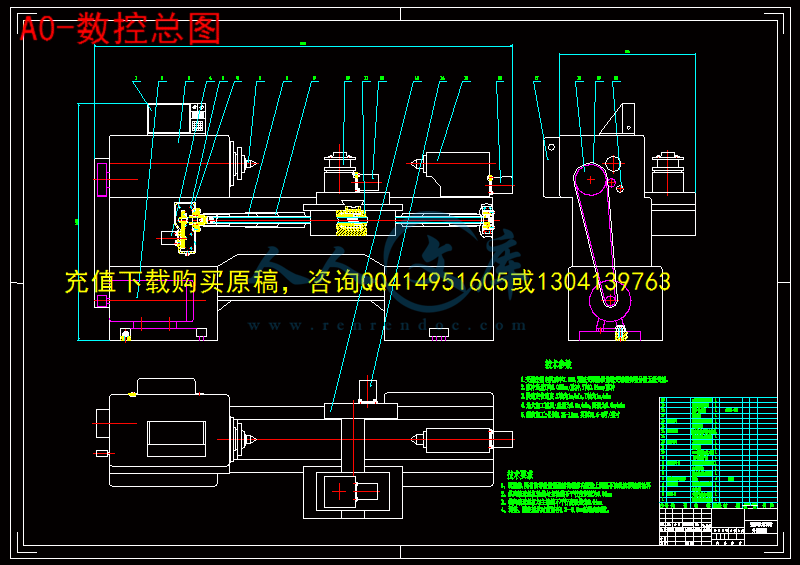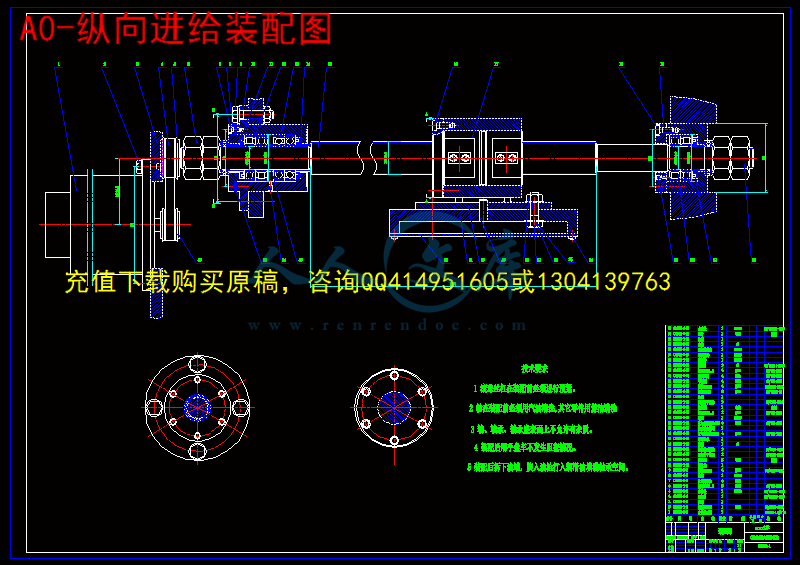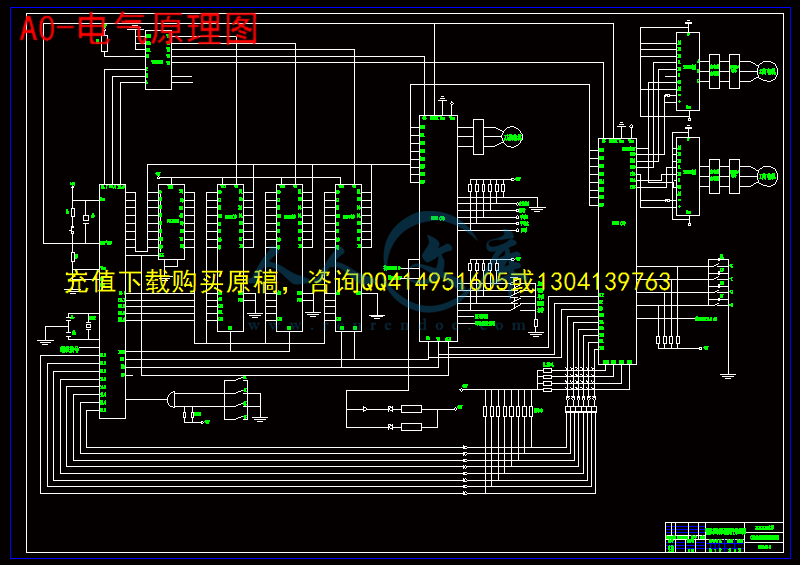摘要
随着计算机技术的飞速发展,发展现代计算机化数字控制(CNC)机床,是当前机械制造业进行技术改造,技术革新的必有之路,是未来工厂自动化的基础。因此,此次对普通机床进给系统的数控化改造设计更显得重要。
目前中国大多数制造行业和企业的生产、加工装备绝大多数是普通机床,机床数控化率远低于美国、日本等国家。如果大量添置全新的数控机床,不仅资金投入量大、成本高,而且又会造成原有设备的闲置浪费。把普通机床改造成数控机床则不失为一条提高数控化率的有效途径。
第一部分是数控机床的概述,第二部分是进给系统的总体设计方案,第三部分是伺服进给机械部分设计计算,第四部分是控制部分的单片机原理设计。
基于步进电机的机械改装减少了人的工作量,把手动转变成为电动。本次改造用了两个步进电机,分别控制机床的两个方向(纵向和横向)的进给,通过带轮带动滚珠丝杠的轴向运动。
基于单片机控制的电子部分设计提高了工作效率和测量的准确度、可信度。该仪器采用了8031单片机。
关键词:车床;数控;丝杠;步进电机;单片机
Abstract
As the development of the computer technology, producing the modern computer numerical control machine becomes the trend of the reformation in the manufacturing industry and the foundation of antomation factories in the future. Therefore, the project of automatizing the machine is important to the prospective study and work.
At present the Chinese majority manufacture professions and enterprise's production, the process unit overwhelming majority is the ordinary engine bed, the engine bed numerical control rate is lower than countries far and so on US, Japan. If acquires the brand-new numerically-controlled machine tool massively, not only the fund inputs are big, cost, will create the original equipment's idle waste. Transforms the numerically-controlled machine tool the ordinary engine bed is enhances the numerical control rate efficient path.
Introduction will be presented in Section 1. The overall designing scheme will be proposed in Section 2 .The calculating and data of mechanical part is in Section 3 and Section 4 is the part of control including the principle of SCM.
The reformation to machine based the stepping motor decreases the workload by turning the hand operation to electric control. Two motors controlling two directions respectively move the ball screws by strap wheels.
The design in electrical part based the SCM improves the product efficiency and the accuracy and stability in the aspect of measuring by using the 8031 SCM.
Key words: lathe; computer numerical control; ball screw; stepping motor; SCM
目录
摘要I
AbstractII
目录III
第1章 绪论1
1.1 数控机床的发展过程1
1.2 数控机床的发展趋势和研究方向1
1.2.1 高速度、高精度化1
1.2.2 多功能化2
1.2.3 智能化2
1.2.4 数控系统小型化2
1.2.5 数控编程自动化3
1.2.6 更高的可靠性3
1.3 数控机床的组成3
1.4 普通车床数控化改造的意义5
第2章 数控化改造总体技术方案的确定6
2.1 设计任务6
2.2 总体方案设计的内容6
2.2.1 伺服驱动6
2.2.2 滚珠丝杠螺母副6
2.2.3 数控装置7
第3章 伺服系统机械部分设计计算8
3.1 设计要求8
3.2 确定系统脉冲当量8
3.3 计算切削力8
3.4 滚珠丝杠螺母副的计算和选择10
3.4.1 纵向滚珠丝杠螺母副的计算和选型10
3.4.2 横向滚珠丝杠螺母副的计算和选型14
3.5 进给伺服系统传动计算18
3.5.1 纵向进给伺服系统传动计算18
3.5.2 横向进给伺服系统传动计算21
3.6 步进电机的计算和选型24
3.6.1 纵向步进电机的计算和选型24
3.6.2 横向步进电机的计算和选型28
第4章 控制系统硬件原理及其控制程序编制32
4.1 主控制器32
4.1.1 主控制器及其选择32
4.1.2 MCS-51系列单片机介绍32
4.2 MCS-51单片机的扩展34
4.2.1 程序存储器EPROM的选型34
4.2.2 数据存储器RAM的选型34
4.3 地址分配及接线方法34
4.3.1 地址的分配34
4.3.2 EPROM、RAM与8031的连接方式34
4.4 接口电路及辅助电路的设计35
4.4.1 接口电路的设计35
4.4.2 辅助电路的具体设计35
4.5 控制系统程序编译36
4.5.1 数控的插补方法36
4.5.2 直线插补工作原理37
4.5.3 圆弧插补工作原理38
参考文献40
致谢41
附件142
附件260
第1章 绪论
1.1 数控机床的发展过程
1946年诞生了世界上第一台电子计算机。6年后,即在1952年,计算机技术应用到了机床上,在美国诞生了第一台数控机床。从此,传统机床产生了质的变化。近半个世纪以来,数控系统经历了两个阶段和六代的发展。
第一阶段:数控(NC)阶段(1952~1970年)。早期采用数字逻辑电路组合成一台机床,专用计算机作为数控系统,被称作硬件连接数控(HARAWIREDNC),简称为数控(NC)。随着元器件的发展,这个阶段经历了三代,即1952年的第一代——电子管时代;1959年的第二代——晶体管时代;1965年的第三代——小规模集成电路时代。
第二阶段:计算机数控(CNC)阶段(1970年~现在)。到1970年,通用小型计算机作为数控系统的核心部件,从此进入了计算机数控(CNC)阶段。到1971年,美国INTEL公司第一次将计算机的两个最核心的部件——运算器和控制器,采用大规模集成电路技术集成在一块芯片上,称之为微处理器(MICROPROCESSOR),又可成为中央处理单元(简称CPU)。
到1974年,微处理器被应用于数控系统。到了1990年,PC的性能已发展到较高的水平,从8位、16位,发展到32位,可以满足作为数控系统核心部件的要求。数控系统从此进入了基于PC的阶段。总之,计算机数控的发展也经历了三代。即1970年的第四代——小型计算机;1974年的第五代——微处理器;1990年的第六代——基于PC。必须指出,数控系统发展到第五代以后,才从根本上解决了可靠性低、价格较为昂贵、应用很不方便(主要是编程困难)等极为关键的问题。因此,数控技术经过了近三十年的发展才走向普及应用。






 川公网安备: 51019002004831号
川公网安备: 51019002004831号